Last updated on September 28th, 2023 at 01:12 pm
Welcome to the expert guide on how to kill ants with boric acid. Ants invading your home can be a persistent nuisance, and boric acid is one of the most time-tested and proven solutions to tackle your ant problem effectively and safely. In this comprehensive article, we will walk you through the steps, techniques, and expert tips to use boric acid for effective ant control. Say goodbye to ant infestations with this expert-recommended approach.
Expert Guide: Using Boric Acid to Eliminate Ants
Understanding Boric Acid for Ant Control
Boric acid, a naturally occurring chemical compound, has gained popularity as a highly effective and budget-friendly solution for tackling ant infestations. It comes in the form of a fine powder. Boric acid is easy to purchase and relatively easy to use, making it a preferred choice for many homeowners. Boric acid is generally safe when used as directed. As you would with any ant killer, exercise extra caution around children and pets who may be more sensitive to these products than adults.
How It Works: Boric acid works as a potent ant killer due to its dual-action mechanism. When ants come into contact with the powder, they are inadvertently exposed to its abrasive properties. As they groom themselves or share food with colony members, they ingest the boric acid particles, causing physical damage to their exoskeleton. This abrasion disrupts the ant’s protective outer layer, leading to dehydration and death.
Furthermore, boric acid is toxic when ingested by ants. It interferes with their digestive system and metabolic processes, ultimately resulting in the demise of the ant. What makes boric acid especially effective is that ants cannot detect its presence, so they unknowingly carry it back to their nest, inadvertently infecting the entire colony.
Why Choose Boric Acid: Using boric acid for ant control offers several advantages. It is non-repellent, meaning ants do not avoid it, making it highly effective in eliminating both visible ants and those hidden within the colony. Unlike some chemical sprays, boric acid does not have a strong odor or leave residues, making it a discreet option for indoor use. Moreover, boric acid provides a long-lasting solution, as its effect continues even after the initial application, which is why we recommend trying to kill ants with boric acid before more extreme measures. It is also less harmful to humans, pets, and the environment compared to many harsher chemical pesticides.
Effectiveness: Boric acid has proven to be remarkably effective in eradicating ant colonies when used correctly. It may take some time to see significant results, but its ability to target both worker ants and the queen ensures the long-term success of ant elimination. Regular application in problem areas and along ant trails can lead to a noticeable reduction in ant activity and, eventually, colony collapse.
In summary, boric acid is a versatile and reliable tool for ant control, offering a safe, budget-friendly, and environmentally friendly solution that can effectively eliminate ant infestations and safeguard your home. For additional details, see the Boric Acid page from the National Pesticide Information Center
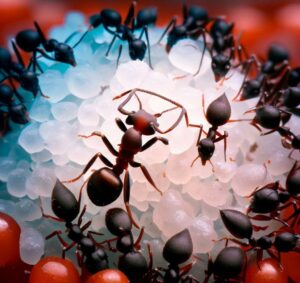
Using Boric Acid to Kill Ants - Step by Step:
Step 1: Gather Materials:
- Boric Acid Powder: Obtain food-grade boric acid powder from a pharmacy or hardware store.
- Powdered Sugar: You’ll need powdered sugar to mix with boric acid to create an enticing bait. Powdered sugar attracts ants to the boric acid, enhancing its effectiveness.
- Small Containers: Choose small containers such as lids or caps to serve as bait stations.
- Protective Gear: Wear gloves to prevent direct contact with boric acid.
Step 2: Mix Bait:
- In a mixing bowl, combine boric acid and powdered sugar in a 1:1 ratio. For example, use 1 tablespoon of boric acid and 1 tablespoon of powdered sugar.
- Thoroughly mix the two substances until they are well blended. The powdered sugar helps mask the bitterness of boric acid, making the bait attractive to ants.
Step 3: Prepare Bait Stations:
- Open the small containers and place a small amount of the boric acid and sugar mixture in each. You only need a small amount as ants are attracted to the scent, not the quantity.
- Ensure the containers have small openings or holes that allow ants to access the bait while preventing larger objects from entering.
Step 4: Place Bait Stations:
- Identify areas with high ant activity. Look for ant trails, entry points, and places where you frequently spot ants.
- Carefully place the bait stations in these locations. Keep them out of reach of children and pets to prevent accidental ingestion.
- Remember, you only need a small amount of the mixture in each bait station.
Step 5: Monitor and Reapply:
- Regularly check the bait stations for ant activity. You should notice ants visiting the stations to feed on the bait.
- If the bait is consumed, reapply the boric acid and sugar mixture as needed. Continue monitoring until ant activity significantly decreases.
Step 6: Be Patient: Boric acid is a slow-acting solution that targets the entire ant colony. Allow time for the bait to be carried back to the nest and distributed among colony members, including the queen. Results may take several days or even weeks to become noticeable, so patience is key.
Step 7: Safety Precautions:
- Always wear gloves when handling boric acid to prevent skin contact.
- Place bait stations away from food preparation areas and ensure they are properly sealed to avoid spillage.
- Clearly label the containers to prevent any confusion and ensure they are not mistaken for food or other substances.
By following these step-by-step instructions and safety precautions, you can effectively use these traps as a targeted method to kill ants with boric acid. Remember that responsible application and patience are essential for successful ant control.
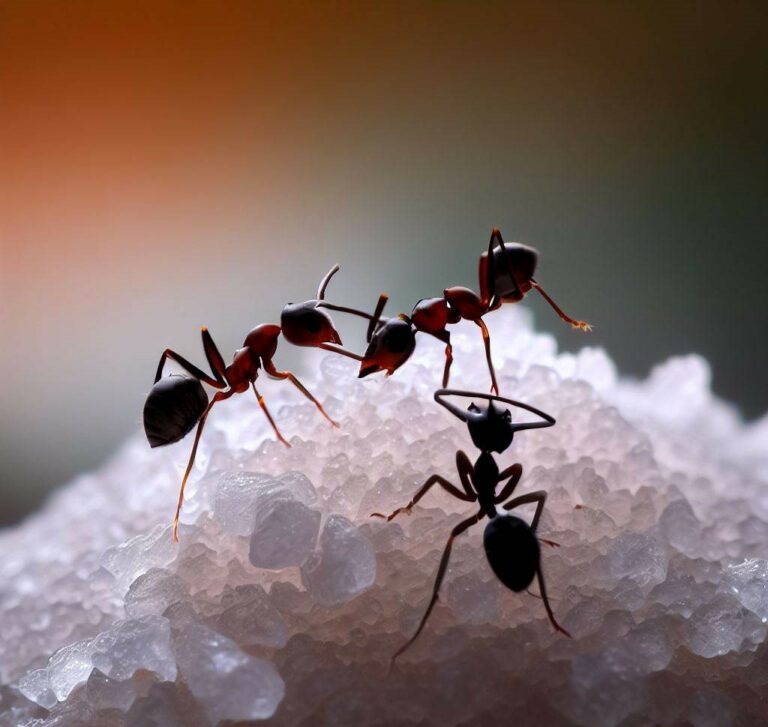
Is Boric Acid A Humane Way to Kill Ants?
Boric acid is considered a humane way to kill ants compared to chemical pesticides. It works by disrupting the ants’ digestive systems, gradually leading to their demise. This process allows ants to carry the boric acid back to their colony, effectively eliminating the entire nest. Unlike harsh chemical sprays, boric acid has low toxicity levels for humans and pets when used as directed. It poses minimal risks to the environment, making it an eco-friendly choice.
However, it’s essential to note that boric acid should still be used responsibly. While it is a safer option, it’s not entirely non-toxic, and ingestion can be harmful. Always keep it out of reach of children and pets, and apply it strategically to minimize unintended exposure. Overall, boric acid strikes a balance between effectiveness and safety, making it a humane choice for ant control.
Pros and Cons of Using Boric Acid:
Pros:
- Effective Colony Control: Boric acid targets the entire ant colony, ensuring long-term eradication.
- Low Toxicity to Humans and Pets: Compared to chemical pesticides, boric acid is relatively low in toxicity to humans and pets. The risks from boric acid are low – but it should not be ingested.
- Eco-Friendly: Boric acid is considered environmentally friendly, breaking down naturally over time.
- Cost-Effective: Boric acid is affordable and available in most drugstores and supermarkets.
Cons:
- Slow-Acting: Boric acid takes time to work, requiring patience as it gradually eliminates the colony.
- Children and Pets: While relatively safe, precautions are necessary to prevent ingestion by children and pets.
- Not Instantaneous: Results may take several days or weeks to become noticeable.
Precautions and Safety Measures:
- Keep Away from Children and Pets: While boric acid is relatively low in toxicity, it’s essential to keep the bait stations out of reach of children and pets to prevent accidental ingestion.
- Avoid Food Contact: Place bait stations away from food preparation areas to prevent contamination. Ensure that the bait stations are securely sealed to prevent any spillage.
- Proper Labeling: Clearly label the containers used for the boric acid mixture to avoid any confusion and ensure they are not mistaken for food or other substances.
Optimizing Effectiveness:
- Strategic Placement: Position bait stations near ant trails, entry points, and areas of high ant activity. By placing the bait where ants frequent, you increase the likelihood of their exposure to the boric acid mixture.
- Patience is Key: Boric acid’s slow-acting nature means that visible results might take time. It’s crucial to be patient and allow the ants to carry the bait back to the nest for maximum impact.
Additional Considerations:
- Non-Ant Targets: While boric acid is relatively safe for humans and pets in small amounts, it’s advisable to avoid using it where non-ant insects might be exposed.
- Complementary Measures: Combining boric acid treatment with other preventive measures, like sealing entry points and practicing good sanitation, enhances the overall effectiveness of your ant control efforts.
FAQ: Boric Acid and Ant Control
Q: Does borax kill ants? A: Yes, borax can be used to kill ants. Borax is a natural mineral compound that works by disrupting ants’ digestive systems and damaging their exoskeletons, ultimately leading to their death.
Q: How long does it take for boric acid to kill ants? A: The timeframe for boric acid to eliminate ants can vary, typically taking several days to a few weeks. Boric acid is slow-acting, targeting the entire ant colony systematically. The process involves ants carrying the boric acid-laden bait back to their nests, where it’s shared among colony members. This gradual spread of the substance leads to the collapse of the colony. Patience is important, as the effectiveness lies in its long-term impact.
Q: How does boric acid kill ants? A: Boric acid’s action against ants is twofold. When ants come into contact with boric acid, they carry it back to their nests. As ants groom and interact, the substance spreads, disrupting their digestive systems and damaging exoskeletons. This results in dehydration and eventual death. Bait stations containing boric acid-laden mixtures enable ants to inadvertently distribute the substance within the colony, targeting the entire population.
Q: Where to buy boric acid for ants? A: Boric acid can be found at pharmacies, hardware stores, and online retailers. Look for food-grade boric acid, as it’s safe for home use. Be sure to read product labels to ensure its suitability for ant control.
Q: How to mix boric acid and sugar to kill ants? A: Mix equal parts boric acid and powdered sugar in a bowl. For example, use 1 teaspoon of each. Blend thoroughly to create an enticing bait. Place small amounts of the mixture in bait stations and position them in areas with ant activity. The sugar attracts ants, while the boric acid works to eliminate them.
Q: Which is better to kill ants, borax or boric acid? A: Both borax and boric acid can be effective against ants. However, boric acid is often preferred due to its lower toxicity and slower action, making it more suitable for colony-wide elimination. Borax can also be used, but it may have higher toxicity and faster effects. Always exercise caution and follow instructions when using either substance for ant control.
Q: Are there safety precautions when using borax for ant control? A: Yes, safety precautions are essential when using borax. While effective, borax can be more toxic than boric acid. Always follow recommended guidelines for mixing and applying borax bait, and ensure that bait stations are placed out of reach of children and pets to prevent accidental ingestion.
Q: Can I use borax to eliminate ant infestations? A: Yes, borax can be used to address ant infestations. By creating bait stations with borax and an attractive substance like powdered sugar, you can effectively target ants and their colonies. However, careful application and adherence to safety guidelines are crucial to ensure successful ant control while minimizing risks.
Summary
Using boric acid to eliminate ants is an effective and eco-friendly method that requires careful planning, proper preparation, and adherence to safety precautions. By following expert recommendations and guidelines, you can leverage boric acid’s slow-acting mechanism to target ant colonies and achieve long-term ant control. Remember to exercise patience, monitor the bait stations, and prioritize safety to successfully eradicate ant infestations while maintaining a safe living environment for your family and pets.

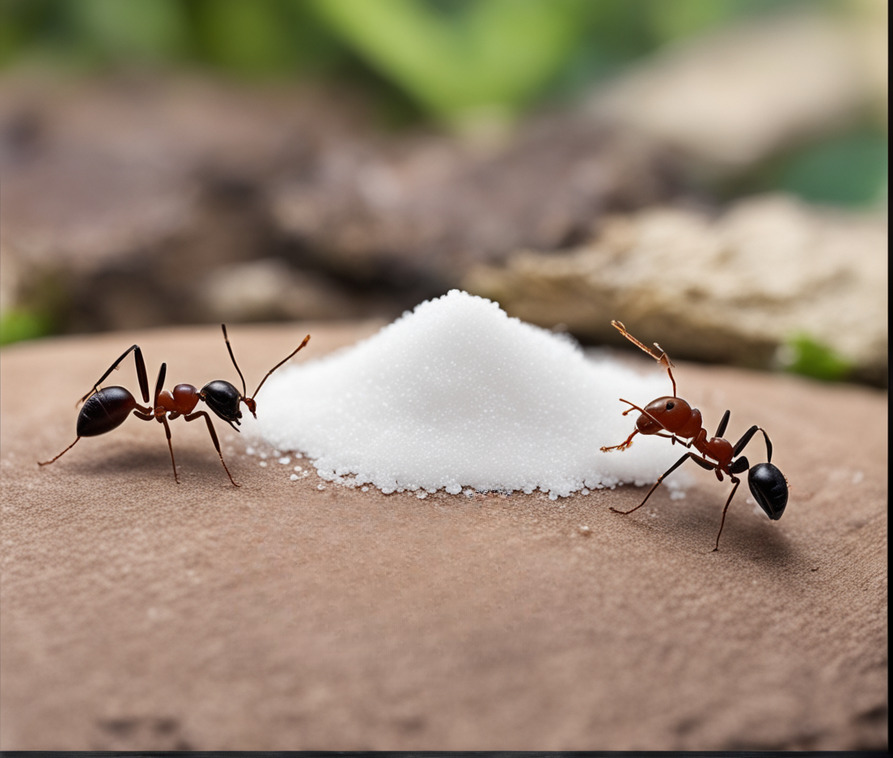
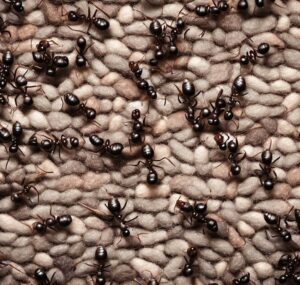
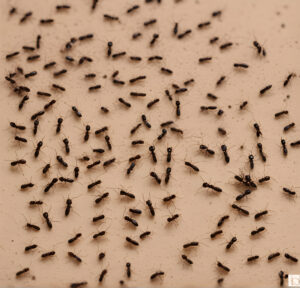
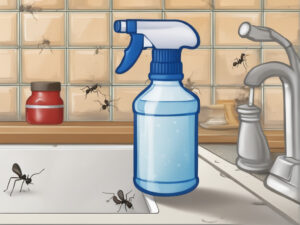
Pingback: The Truth About Flying Ant Bites: All Your Questions Answered - The Bug Experts
Pingback: How to Get Rid of Pharaoh Ants: A Comprehensive Guide - The Bug Experts
Pingback: The Ghost Ant Guide: How To Get Rid of Ghost Ants - The Bug Experts
First the author says “What makes boric acid especially effective is that ants cannot detect its presence, so they unknowingly carry it back to their nest, inadvertently infecting the entire colony” and then the author says “The powdered sugar helps mask the bitterness of boric acid, making the bait attractive to ants.”
Was this written by different people who didn’t read the other half?
You have to get them to eat right? If they can’t detect it’s presence and have no inclination to eat it or feed it to their queen, they have no need to do your work for you and will likely only pick it up by accident. It will kill them on its own sure, but by baiting it you are probably more likely to get them to use it to kill each other while you stand back and laugh at their destruction!, bwaaahh hahahahahaha.